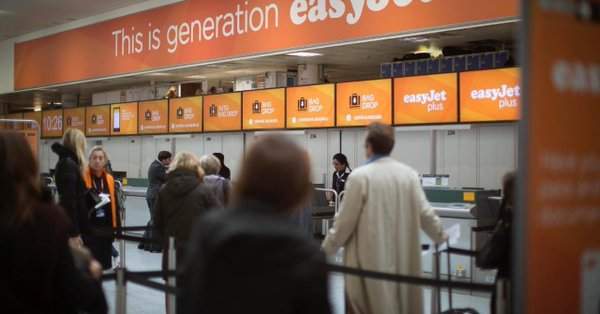
Today, low-cost airline Wizz Air announced it will set up its first UK airport base at London’s Luton airport.
But how much money do budget airlines make and are they really profitable?
Verdict takes a look at some of the biggest names in the industry:
1. WizzAir
The Hungarian discount carrier is the largest low-cost airline in Central and Eastern Europe.
Founded in 2003, Wizzair boasts a fleet of 74 planes flying over 500 routes and will soon have 28 bases.
Its first flight took off in May 2004 from Katowice, a small city in southwestern Poland.
How well do you really know your competitors?
Access the most comprehensive Company Profiles on the market, powered by GlobalData. Save hours of research. Gain competitive edge.

Thank you!
Your download email will arrive shortly
Not ready to buy yet? Download a free sample
We are confident about the unique quality of our Company Profiles. However, we want you to make the most beneficial decision for your business, so we offer a free sample that you can download by submitting the below form
By GlobalDataIn 2015, Wizz Air was admitted to the London Stock Exchange (LSE), becoming a publicly listed company.
It currently employs approximately 3,000 people.
In the three months to 31 December 2016, the airline carried 5.7m passengers, and a total of 20m over the course of 2016.
Last year, the business delivered a profit of £164m while revenues surged to £291m.
However, earlier this month, shares in WizzAir dropped seven percent to £16.53.
The company blamed bad weather conditions and low air fares for the slump.
Wizz Air’s chief executive Jozsef Varadi conceded the “downward trend” on air fares “looks likely to continue [and] management believes it is prudent to trim the company’s guidance for net profit.”
2. Easyjet
Easyjet was founded in 1995 by Stelios Haji-Ioannou when he was just 28.
The British entrepreneur of Greek origin is now worth $1.4bn.
Easyjet’s inaugural flights in November 1995 flew from London Luton to Glasgow and then to Edinburgh.
The ad campaign slogan “Making flying as affordable as a pair of jeans – £29 one way” put Easyjet on the map as a leading low-cost carrier.
In response to its first ever flight promotion in 1996 after the airline’s formal launch, the Easyjet sales team received over 4m calls in 4 days.
Within eight months, Easyjet expanded into Europe, with flights to Amsterdam, Nice and Barcelona.
The company now employs over 10,000 people, including 2,865 pilots and 6,516 cabin crew.
Over 1.3m monthly online bookings are made on Easyjet.com, generating £10m per day in revenue.
Easyjet is now Europe’s second-biggest low-cost airline, with a fleet of over 200 aircrafts.
In 2016, 73.1m passengers travelled on Easyjet flights, with total revenue at £4.67bn.
However, pre-tax profits in the year to 30 September 2016 fell 27.9 percent to £495m.
Last month, EasyJet warned that the outlook for the year ahead remains “tough.”
The company’s chief executive Carolyn McCall pointed to higher fuel costs, a weak pound following the Brexit vote, and the increasing prevalence of terror attacks across Europe for lower earnings figures.
Shares in the low-cost carrier declined as much as 10 percent at the end of January.
The company said its profit before tax would be £105m lower than expected for the 2017 financial year.
3. Ryanair
The biggest airline in the UK and Europe, Ryanair’s total revenue hit £5.58bn in 2016.
Operating over 1,800 flights per day, the Irish airline carried 9m passengers in December alone.
It has 86 bases across Europe and North Africa, operating in 33 countries globally.
Ryanair was launched in 1984 by Christopher Ryan, Liam Lonergan and Irish businessman Tony Ryan, after whom the company is named.
Operations began in 1985 with a 15-seat aircraft flew from Waterford in Ireland to Gatwick.
The first cabin crew recruits had to be less than 5ft 2in tall to fit on the plane.
The first commercial flights a year later from Dublin to London Luton were sold for £99 return— less than half the price of the same route on British Airways.
Ryanair’s average fares were £28 per passenger in the October-to-December period, to compete with other discount carriers in an increasingly crowded market.
Despite its low fares, the airline caused controversy last year when it emerged that customers were charged “hidden fees” including £160 to change names on tickets.
Ryanair, like other low-cost carriers has been hit by the weak sterling and terrorism fears. In its most recent results, profits slid eight percent to £82m.
However, it said it was “maintaining its full-year profit guidance in the range of 1.30bn to 1.35bn euros“.
4. JetBlue
The American low-cost airline is the sixth largest carrier in the US with a revenue of £5.31bn for the full year 2016.
It was one of the few carriers which still made money after the 9/11 attacks when nearly all major airlines suffered record profit losses.
With an average of 925 daily flights, JetBlue carries 35m customers a year.
Founded in 2000, the airline has a fleet of 227 planes, and 20,000 crew members.
Jet Blue’s first flight was from New York JFK to Fort Lauderdale, and it now flies to 22 countries throughout the Americas. JetBlue is currently the largest airline in Puerto Rico, offering up to 43 daily departures.
In August last year, JetBlue became the first airline to operate US-Cuba flights.
Last month,the US budget carrier forecast a fall in revenue and markets reacted negatively to the news.
Shares dropped 3.44 percent to £17 at the end of January.
JetBlue reported net income of £138m, about £14m less than it made in the same period in 2015.
The company may be forced to stop flying some routes that are less popular to cope with the dip in revenue.
5. FlyBe
The Exeter-based airline is the largest independent regional carrier in Europe.
The company’s total revenue for the full year 2015/16 was £623.8m.
The airline launched in 1979 as Jersey European Airways following the merger of Intra Airways and Express Air Services.
FlyBe now carries 7m passengers a year on 149 routes, from 62 destinations in 9 countries.
At the moment, the majority of FlyBe routes cost between £30 to £50 for a one way ticket.
In the first half of the 2016 financial year, the company’s pre-tax profits nosedived 25 percent to £15.9m.
“The trading statement shows Flybe is only selling around two thirds of its available seats, and in the first few weeks of 2017 revenue per seat sold fell backwards, which is not an encouraging combination,” said Laith Khalaf, analyst at Hargreaves Lansdowne at the end of January.
Rising costs of jet fuel and low prices due to overcapacity meant profits were lower than expected.







